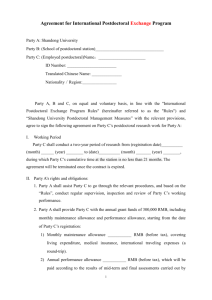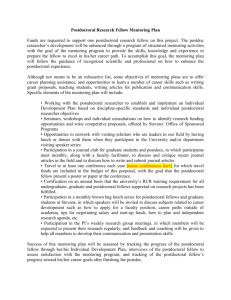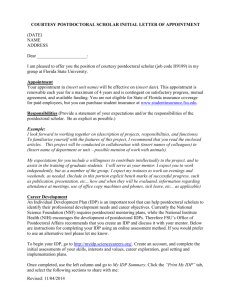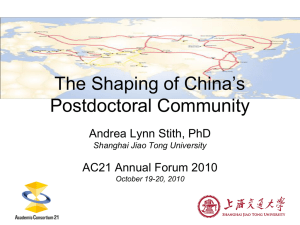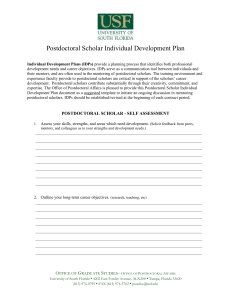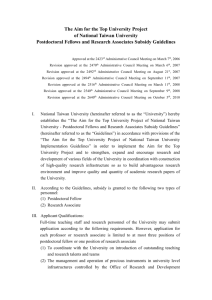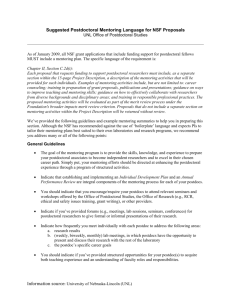547-1664-1-PB
advertisement
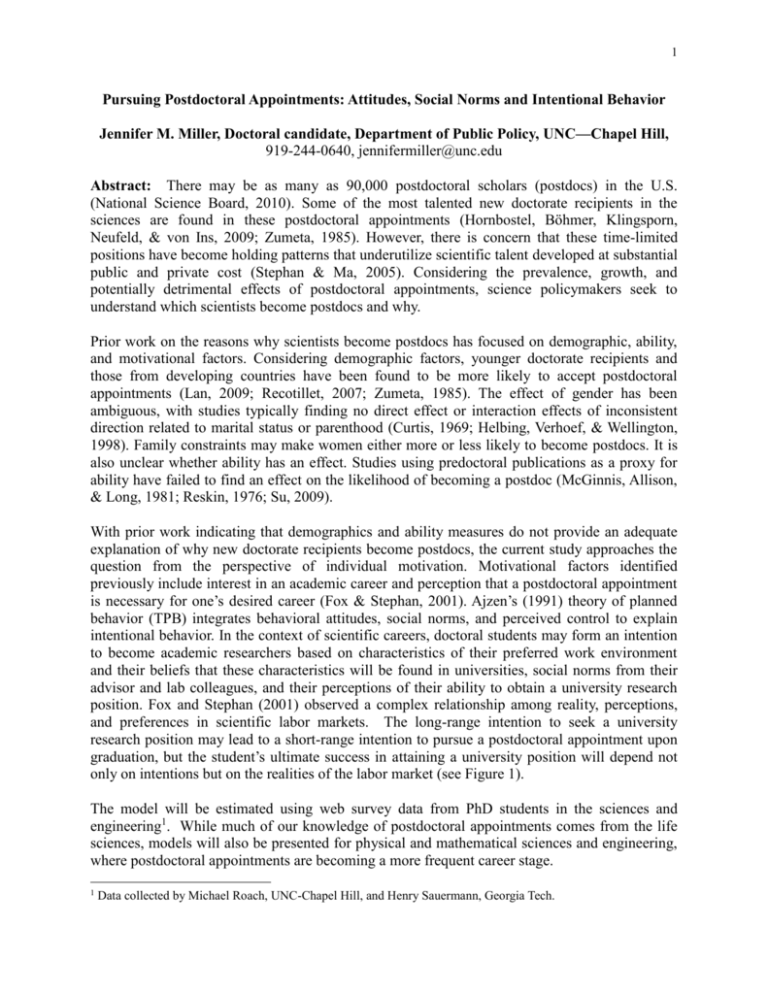
1 Pursuing Postdoctoral Appointments: Attitudes, Social Norms and Intentional Behavior Jennifer M. Miller, Doctoral candidate, Department of Public Policy, UNC—Chapel Hill, 919-244-0640, jennifermiller@unc.edu Abstract: There may be as many as 90,000 postdoctoral scholars (postdocs) in the U.S. (National Science Board, 2010). Some of the most talented new doctorate recipients in the sciences are found in these postdoctoral appointments (Hornbostel, Böhmer, Klingsporn, Neufeld, & von Ins, 2009; Zumeta, 1985). However, there is concern that these time-limited positions have become holding patterns that underutilize scientific talent developed at substantial public and private cost (Stephan & Ma, 2005). Considering the prevalence, growth, and potentially detrimental effects of postdoctoral appointments, science policymakers seek to understand which scientists become postdocs and why. Prior work on the reasons why scientists become postdocs has focused on demographic, ability, and motivational factors. Considering demographic factors, younger doctorate recipients and those from developing countries have been found to be more likely to accept postdoctoral appointments (Lan, 2009; Recotillet, 2007; Zumeta, 1985). The effect of gender has been ambiguous, with studies typically finding no direct effect or interaction effects of inconsistent direction related to marital status or parenthood (Curtis, 1969; Helbing, Verhoef, & Wellington, 1998). Family constraints may make women either more or less likely to become postdocs. It is also unclear whether ability has an effect. Studies using predoctoral publications as a proxy for ability have failed to find an effect on the likelihood of becoming a postdoc (McGinnis, Allison, & Long, 1981; Reskin, 1976; Su, 2009). With prior work indicating that demographics and ability measures do not provide an adequate explanation of why new doctorate recipients become postdocs, the current study approaches the question from the perspective of individual motivation. Motivational factors identified previously include interest in an academic career and perception that a postdoctoral appointment is necessary for one’s desired career (Fox & Stephan, 2001). Ajzen’s (1991) theory of planned behavior (TPB) integrates behavioral attitudes, social norms, and perceived control to explain intentional behavior. In the context of scientific careers, doctoral students may form an intention to become academic researchers based on characteristics of their preferred work environment and their beliefs that these characteristics will be found in universities, social norms from their advisor and lab colleagues, and their perceptions of their ability to obtain a university research position. Fox and Stephan (2001) observed a complex relationship among reality, perceptions, and preferences in scientific labor markets. The long-range intention to seek a university research position may lead to a short-range intention to pursue a postdoctoral appointment upon graduation, but the student’s ultimate success in attaining a university position will depend not only on intentions but on the realities of the labor market (see Figure 1). The model will be estimated using web survey data from PhD students in the sciences and engineering1. While much of our knowledge of postdoctoral appointments comes from the life sciences, models will also be presented for physical and mathematical sciences and engineering, where postdoctoral appointments are becoming a more frequent career stage. 1 Data collected by Michael Roach, UNC-Chapel Hill, and Henry Sauermann, Georgia Tech. 2 Policy implications of this study include identifying avenues to better inform early-career scientists’ choices given the scarcity of faculty positions and the increasing prevalence of postdoctoral appointments. A recent study of entrepreneurship education found that it is possible to improve sorting on intention to start a company by increasing students’ knowledge of skill and resource requirements for entrepreneurs (von Graevenitz, Harhoff, & Weber, 2010). Fig. 1. Model of intention to pursue a university research position as a mediator of the intention to pursue a postdoctoral appointment References Ajzen, I. (1991). The theory of planned behavior. Organizational behavior and human decision processes, 50(2), 179-211. Curtis, R. B., & National Research Council. (1969). The invisible university: Postdoctoral education in the United States. Report of a study conducted under the auspices of the National Research Council. Washington, DC: National Academy of Sciences. Fox, M. F., & Stephan, P. E. (2001). Careers of young scientists: Preferences, prospects and realities by gender and field. Social Studies of Science, 31(1), 109-122. Helbing, C. C., Verhoef, M. J., & Wellington, C. L. (1998). Gender and the postdoctoral experience. Science and Public Policy, 25(4), 255-264. Hornbostel, S., Böhmer, S., Klingsporn, B., Neufeld, J., & von Ins, M. (2009). Funding of young scientists and scientific excellence. Scientometrics, 79(1), 171-190. Lan, X. (2009). Permanent visas and temporary jobs: Evidence from postdoctoral participation of foreign PhDs in the U.S. University of Virginia. McGinnis, R., Allison, P. D., & Long, J. S. (1981). Postdoctoral training in bioscience: Allocation and outcomes. Social Forces, 60, 701. National Science Board. (2010). Science and engineering indicators 2010. Arlington, VA. Recotillet, I. (2007). PhD Graduates with post-doctoral qualification in the private sector: Does it pay off? Labour, 21(3), 473-502. Reskin, B. F. (1976). Sex differences in status attainment in science: The case of the postdoctoral fellowship. American Sociological Review, 41(4), 597-612. Stephan, P. E., & Ma, J. (2005). The increased frequency and duration of the postdoctorate career stage. American Economic Review, 95(2), 71-75. Su, X. (2009). Postdoctoral training, departmental prestige and scientists’ research productivity. The Journal of Technology Transfer. von Graevenitz, G., Harhoff, D., & Weber, R. (2010). The effects of entrepreneurship education. Journal of Economic Behavior & Organization, 76(1), 90-112. Zumeta, W. M. (1985). Extending the educational ladder: The changing quality and value of postdoctoral study. Lexington, Mass.: Lexington Books.
